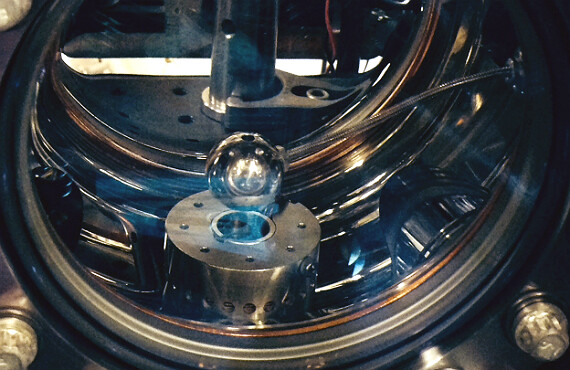Experiment Attempts to Snare Penn Astrophysicist’s Dark Energy ‘Chameleons’
If dark energy is hiding in the form of hypothetical particles called “chameleons,” a team of researchers at the University of Pennsylvania and the University of California, Berkeley, plans to flush them out.
The results of an experiment published in Science narrows the search for chameleons a thousand times compared to previous tests. The researchers hope that their next experiment will either expose chameleons or similar ultralight particles as the real dark energy, or prove they were nothing more than an illusion.
The study was led by Holger Müller, an assistant professor of physics at Berkeley and a faculty scientist at Lawrence Berkeley National Laboratory; Berkeley post-doctoral fellow Paul Hamilton; and Justin Khoury, an associate professor in the Department of Physics and Astronomy in Penn’s School of Arts & Sciences.
Dark energy was first discovered in 1998 when scientists observed that the universe was expanding at an ever-increasing rate, apparently pushed apart by an unseen pressure permeating all of space and making up about 68 percent of the energy in the cosmos.
Since then, theorists have proposed numerous ideas to explain the still mysterious energy. It could be simply woven into the fabric of the universe, a cosmological constant that Albert Einstein proposed in the equations of general relativity and then disavowed. Or it could be quintessence, represented by any number of hypothetical particles, including offspring of the Higgs boson.
“One possible reason why dark energy particles haven’t been detected is that they’re hiding from us,” Khoury said.
In 2004, he proposed that dark energy particles, which he dubbed “chameleons,” vary in mass depending on the density of surrounding matter.
In the emptiness of space, chameleons would have a small mass and exert force over long distances, able to push space apart. In a laboratory, however, with matter all around, they would have a large mass and extremely small reach. In physics, a low mass implies a long-range force, while a high mass implies a short-range force.
This would be one way to explain why the energy that dominates the universe is hard to detect in a lab.
“The chameleon field is light in empty space,” Müller said, “but as soon as it enters an object it becomes very heavy and so couples only to the outermost layer of a big object and not to the internal parts. It would pull only on the outermost nanometer.”
When Hamilton read an article by theorist Clare Burrage last August outlining a way to detect such a particle, he suspected that the atom interferometer he and Müller had built at UC Berkeley would be able to detect chameleons if they existed. Müller and his team have built some of the most sensitive detectors of forces anywhere, using them to search for slight gravitational anomalies that would indicate a problem with Einstein’s General Theory of Relativity. While the most sensitive of these are physically too large to sense the short-range chameleon force, the team immediately realized that one of their less sensitive atom interferometers would be ideal.
Burrage suggested measuring the attraction caused by the chameleon field between an atom and a larger mass, instead of the attraction between two large masses, which would suppress the chameleon field to the point of being undetectable.
That is what the researchers did. They dropped cesium atoms above an inch-diameter aluminum sphere and used sensitive lasers to measure the forces on the atoms as they were in free fall for about 10 to 20 milliseconds. They detected no force other than Earth's gravity, which rules out chameleon-induced forces a million times weaker than gravity. This eliminates a large range of possible energies for the particle.
Experiments at CERN in Geneva and the Fermi National Accelerator Laboratory in Illinois, as well as other tests using neutron interferometers, also are searching for evidence of chameleons, so far without luck. The Penn and Berkeley researchers are currently improving their experiment to rule out all other possible particle energies or, in the best-case scenario, to discover evidence that chameleons really do exist.
“Holger has ruled out chameleons that interact with normal matter more strongly than gravity,” Khoury said, “but he is now pushing his experiment into areas where chameleons interact on the same scale as gravity, where they are more likely to exist.”
Their experiments may also help narrow the search for other hypothetical screened dark energy fields, such as symmetrons, which were also proposed by Khoury with Penn postdoctoral researcher Kurt Hinterbichler in 2010, and forms of modified gravity, such as so-called f(R) gravity
“In the worst case, we will learn more of what dark energy is not. Hopefully, that gives us a better idea of what it might be,” Müller said. “One day, someone will be lucky and find it.”
The work was funded by the David and Lucile Packard Foundation, National Science Foundation and National Aeronautics and Space Administration. Berkeley physics graduate students Matt Jaffe and Quinn Simmons, along with post-doctoral fellow Philipp Haslinger, contributed to the research.








